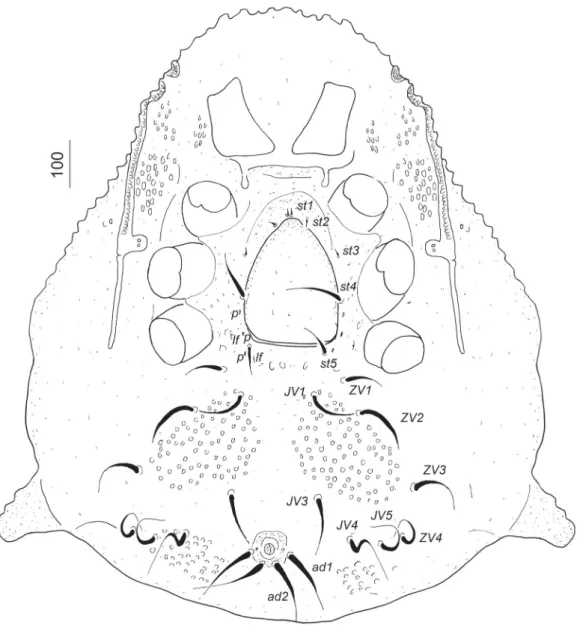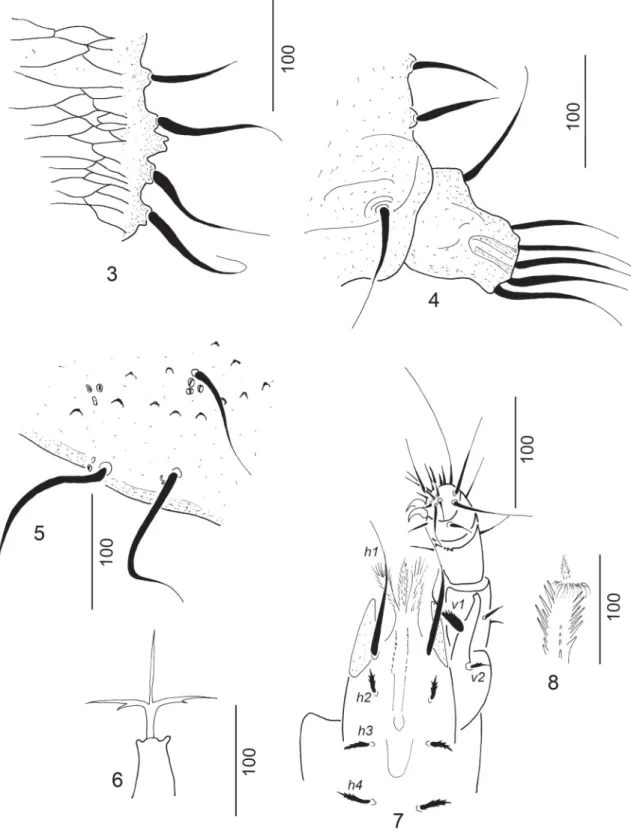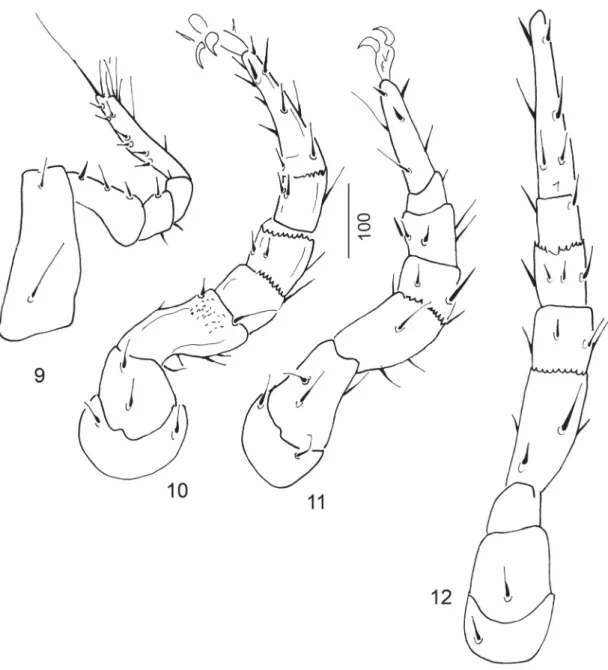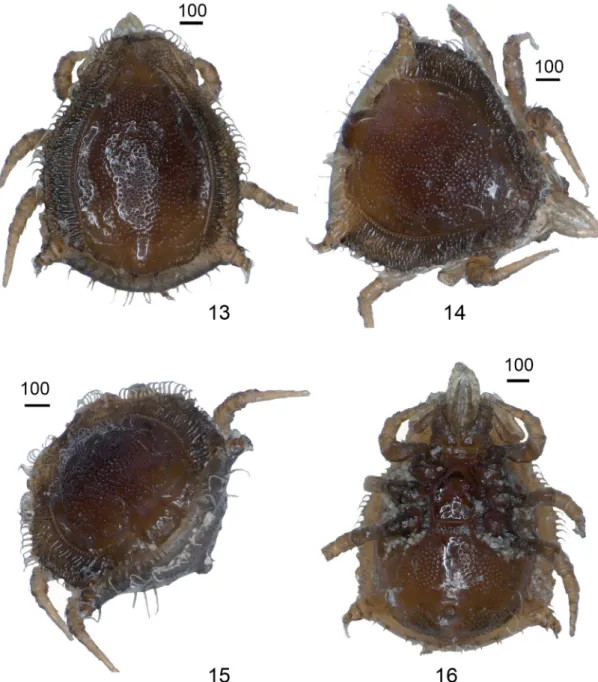INTRODUCTION
The family Eutrachytidae is a widely distributed group of Uropodina mites (Wiśniewski, 1993). The majority of its species occurs in the Neotropical and Oriental regions, but some species have also been reported from the Palearctic, and one species from Africa (Wiśniewski, 1993). So far only Deraiophorus endrodyi Hirschmann, 1973 is known from that continent, having been collected in Ghana, West Africa.
With more than 50 described and named species the systematics of this family is poorly known. Moraza et al. (2016) mentioned that this family is missing from the comprehensive “Manual of Acarology” (Lindquist et al., 2009). In the same work the Eutrachytidae are presented as a single family which contains all the known
“eutrachytid” and “deraiphorid” mites separated into eight genera (Moraza et al., 2016).
During my visits to the Natural History Museum of Geneva numerous soil samples from Africa were investigated, and one sample from Ivory Coast contained two unusual specimens of eutrachytid mites which are described herein as a new genus.
MATERIAL AND METHODS
The two specimens examined were cleared in lactic acid for a week and subsequently investigated on half-covered slides with a well under a Leica 1000 microscope. Legs and chelicerae are not described in detail, because they provide very little relevant taxonomic information in Uropodina. Moreover, a detailed study of the chelicera
would necessitate breaking the specimens, which, in the case of type specimens, I wanted to avoid. The drawings were made with the aid of a drawing tube on a Leica 1000 microscope; the photos were taken by a KEYENCE VHX-5000 digital microscope with a 20-200× objective (Keyence Co., Osaka, Japan). Both specimens are stored in ethanol and deposited in the Natural History Museum in Geneva. Abbreviations: h = hypostomal setae, st = sternal setae, ad = adanal setae, lf = lyriform fi ssures, p = gland pores; JV and ZV are ventral setae. All measurements and the scales in the fi gures are given in micrometres (μm).
SYSTEMATICS
Family Eutrachytidae Trägårdh, 1944 Mahnertellina gen. nov.
Type species: Mahnertellina paradoxa sp. nov.
Diagnosis: Idiosoma yellowish brown, shape triangular, with a pair of long posterior processes. Marginal shield of dorsal idiosoma reduced at level of posterior processes. Peritremes long, anterior part of prestigmatid section of peritremes with some bends. Genital shield of female scutiform. Internal malae on gnathosoma pilose, setae h1 smooth, other setae on gnathosoma serrate.
Setae v1 on palp trochanter situated on a long ventral and apically curved process. Adanal setae long and robust.
A second species of the family Eutrachytidae (Acari: Uropodina) in Africa:
Mahnertellina paradoxa gen. nov., sp. nov. from the Ivory Coast
Jenő Kontschán
Plant Protection Institute, Centre for Agricultural Research, H-1525 Budapest, P.O. Box 102, Hungary.
E-mail: kontschan.jeno@agrar.mta.hu
Abstract: The second African species of the family Eutrachytidae is discovered and described as Mahnertellina paradoxa gen. nov., sp. nov. on the basis of two females from the Ivory Coast. The new genus is similar to Dicornutophorus Hirschmann, 1979, but the marginal shield of the new genus is reduced and the pygidial shield is absent, whereas in Dicornutophorus the marginal shield is complete and the pygidial shield is present.
Keywords: Taxonomy - new taxa - West-Africa.
Manuscript accepted 16.01.2020 DOI: 10.35929/RSZ.0007
specimens of the genus Dicornutophorus are from the Neotropical region (Bolivia and Brazil; Wiśniewski, 1993), whereas specimens of the new genus and species were found in West Africa.
Zoogeographical note: Till today the African eutrachytids are mostly unknown. The discovery of a second species of this family in Africa indicates that additional closely related species live in the soils of the West African rain forests.
Mahnertellina paradoxa sp. nov.
Figs 1-16
Specimens examined: MHNG; female holotype and 1 female paratype; “Afrique Occidentale: Côte d’Ivoire, Etymology: The new genus is dedicated to
Professor Volker Mahnert (1943-2018), an excellent pseudoscorpion specialist and a former director of the Natural History Museum in Geneva (Schwendinger, 2019). The gender of the new genus name is feminine.
Notes: Up to now only one genus of the family Eutrachytidae is characterized by long posterior pro- cesses of the idiosoma: the genus Dicornutophorus Hirschmann, 1979. This genus possesses a pygidial shield and the marginal shield is complete. These two structures are absent in the new genus. The v1 setae on the palp trochanter of previously described eutrachytid mites is situated on the surface of the trochanter, whereas in the new genus this seta is placed on a long and apically curved process. All previously collected
Fig. 1. Mahnertellina paradoxa gen. nov., sp. nov., dorsal side of idiosoma of female holotype.
forêt de Tai, environs de la station, tamisage de bois mort”; 20 October 1980; leg. V. Mahnert and J.L. Perret.
Etymology: The epithet, an adjective, refers to the unusual character states of the new species.
Diagnosis: Same as for the genus.
Description of female: Dorsal idiosoma (Figs 1, 13-15). Idiosoma yellowish brown, triangular, with two posterior processes, 1290-1300 long and 715-720 wide (n=2), all setae on dorsal idiosoma smooth and needle- like. A pair of robust (110-115 long and 60-70 wide) idiosomal processes situated on posterolateral margin of body, these bearing six to seven 100-105 long setae (Fig. 4). Dorsal and marginal shields completely fused in anterior area. Dorsal shield covered by small (8×7) oval pits almost on whole surface except for narrow strips close to its lateral margins. Dorsal shield with
24-25 pairs of dorsal setae, these about 95-110 long and associated with gland pores (Fig. 5). Caudal area of dorsal shield with an elevated, rounded area bearing a pair of about 105-108 long setae. Two pairs of setae (about 103-108 long) situated on caudal margin of dorsal shield lateral to the elevated area. Marginal shields reduced at level of posterolateral processes, with reticulate sculptural pattern (Fig. 3). Thirty-nine to forty pairs of about 107-115 long setae presented on marginal shields and situated on small protuberances.
Pygidial region unsclerotized, with soft membraneous integument, lacking scutal elements.
Ventral idiosoma (Figs 2, 16). Base of tritosternum narrow, with two anterolateral humps; tritosternal lacinia three-tined, lateral tines each with a small medial spine and pointed, central tine slightly longer and smooth (Fig. 6). Sternal shield with two anterior incisions and without sculptural pattern. Sternal setae st1-st3 minute
Fig. 2. Mahnertellina paradoxa gen. nov., sp. nov., ventral side of idiosoma of female holotype.
(about 13-17), st4 (about 114-120) and st5 (about 60-70) longer. All sternal setae smooth and needle-like. Setae st1 situated close to each other and close to anterior margin of genital shield, st2 close to st1, st3 at level of anterior margin of coxae III, st4 at level of anterior
margin of coxae IV, and st5 close to posterior edge of genital shield. Two pairs of lyriform fi ssures and three pairs of gland pores situated around st5. One pair of large fi elds of oval pits situated posterior to coxae IV, and another pair of large fi elds of oval pits visible lateral to
Figs 3-8. Mahnertellina paradoxa gen. nov., sp. nov., female holotype. (3) Setae and sculptural pattern on marginal shield. (4) Area of posterior idiosomal process. (5) Setae and ornamentation on caudal area of dorsal shield. (6) Tritosternum. (7) Ventral side of gnathosoma with palp. (8) Epistome.
anal opening on ventral shield. Eight pairs of smooth and long (about 95-130) ventral setae in three groups situated on ventral shield. Three pairs of setae (JV1, ZV1, ZV2) placed anterior to fi rst fi elds of oval pits, two pairs (JV3, ZV3) posterior to these fi elds, three pairs (JV4, JV5, ZV4) of strongly curved setae present lateral to anal opening.
Anal opening very small (about 20-24×19-22), two pairs of long (about 135-145), smooth and needle-like adanal setae present; postanal seta absent. Genital shield about 245-250 long and about 180-185 wide, scutiform, its anterior margin straight, not pointed as in other eutrachytid mites, its surface smooth. Tracheal stigmata situated between coxae II and III; prestigmatic section of peritremes long, with two anterior bends, poststigmatic part short and straight. Leg grooves (pedofossae) absent.
Gnathosoma (Fig. 7). Corniculi horn-like, internal malae markedly longer than corniculi and apically pilose.
Hypostomal setae h1 long (about 135-140 in length), smooth and needle-like; h2, h3 and h4 shorter (about 22- 33) and marginally serrate. Setae v1 on palp trochanter robust, serrate and situated on a long and apically curved process. Setae v2 on palp trochanter marginally serrate, other setae on palp smooth. Epistome apically pilose and densely serrate (Fig. 8). Fixed digit of chelicerae longer than movable digit, other details not visible without breaking the type specimens.
Legs (Figs 9-12). Legs I 570-585 long, legs II 685-690, legs III 645-655, legs IV 900-910. Legs I without tarsal claws. Leg setae mostly smooth and needle-like.
Figs 9-12. Mahnertellina paradoxa gen. nov., sp. nov., legs of female holotype in ventral view. (9) Leg I. (10) Leg II. (11) Leg III. (12) Leg IV.
ACKNOWLEDGEMENTS
I am very grateful to Dr Peter Schwendinger (MHNG) for his kind hospitality during my stays in Geneva. I also thank Dr Peter Mašán who kindly reviewed the manuscript and suggested additions which led to a major improvement.
REFERENCES
Hirschmann W. 1973. Gangsystematik der Parasitiformes, Teil 150. Adulten-Gruppen, Rumpfgestalt- und Rücken- fl ächengbestimmungstabelle von 36 Deraiophorus-Arten,
(Dinychini, Uropodinae). Acarologie. Schriftenreihe für Vergleichende Milbenkunde 19: 56-60.
Hirschmann W. 1979. Stadiensystematik der Parasitiformes, Teil 1. Stadienfamilien und Stadiengattungen der Atrichopy- gidiina, erstellt im Vergleich zum Gangsystem Hirschmann, 1979. Acarologie. Schriftenreihe für Vergleichende Milben- kunde 26: 57-68.
Lindquist E.E., Krantz G.W., Walter D.E. 2009. Order Mesostig- mata [pp. 124-232]. In: Krantz G.W., Walter D.E. (eds). A Manual of Acarology. Third edition. Texas Tech University Press, Lubbock, 807 pp.
Moraza M.L., Kontschán J., Sahoo Z., Ansari Z.A. 2016. A new species of Eutrachytes (Acari: Uropodina: Eutrachytidae) associated with the Indian mangrove (Avicennia offi cinalis).
Acarologia 56(1): 73-89.
Figs 13-16. Photos of Mahnertellina paradoxa gen. nov., sp. nov., female holotype. (13) Dorsal view of idiosoma. (14) Anterior view of dorsal side of idiosoma. (15) Caudal view of dorsal side of idiosoma. (16) Ventral view of idiosoma.
Wiśniewski J. 1993. Gangsystematik der Parasitiformes. Teil 549. Die Uropodiden der Erde nach zoogeographischen Regionen und Subregionen geordnet (mit Angabe der Lande). Acarologie. Schriftenreihe für Vergleichende Mil- benkunde 40: 221-291.
Schwendinger P. 2019. Volker Mahnert 3 December 1943 – 23 November 2018. Revue suisse de Zoologie 126(1): 1-16.
Trägårdh I. 1944. Systematik der Uropodinen. Entomologisk Tidskrift 65: 173-186.



